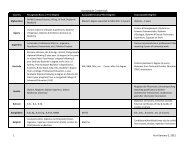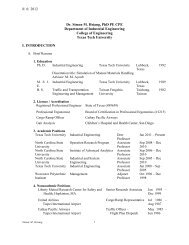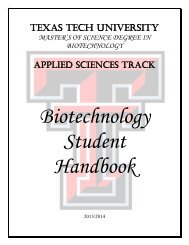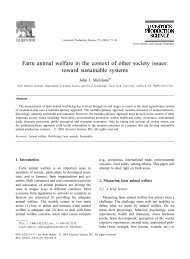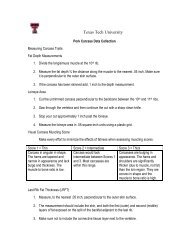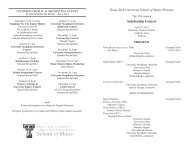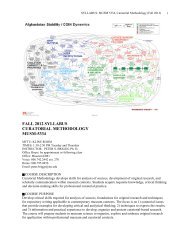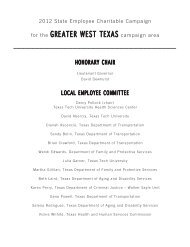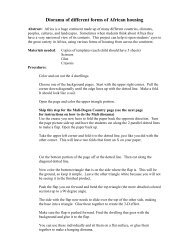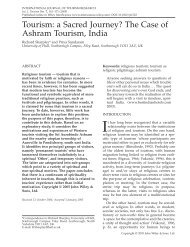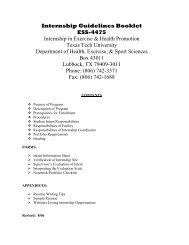Development of Tour Uriely 2005
Development of Tour Uriely 2005
Development of Tour Uriely 2005
Create successful ePaper yourself
Turn your PDF publications into a flip-book with our unique Google optimized e-Paper software.
206 THE TOURIST EXPERIENCE<br />
may engage in different experiences, it also points toward the existence<br />
<strong>of</strong> multi-type individual backpackers who correspond to more than one<br />
mode <strong>of</strong> experience across their backpacking biography or even during<br />
a single trip (<strong>Uriely</strong> et al 2002). In this regard, this backpacker is<br />
akin to Feifer’s (1985) earlier conceptualization <strong>of</strong> the ‘‘post tourist’’,<br />
who enjoys the movement across different types <strong>of</strong> experiences in a<br />
single excursion.<br />
The Role <strong>of</strong> Subjectivity. The current notion <strong>of</strong> the tourist experience as<br />
a diverse phenomenon is accompanied by another development in<br />
which attention is shifted from the displayed objects provided by the<br />
industry to the tourist subjective negotiation <strong>of</strong> meanings as a determinant<br />
<strong>of</strong> the experience. This shift is evident in various studies, including<br />
the conceptualization <strong>of</strong> authenticity, the emerging research area<br />
<strong>of</strong> heritage tourism, as well as the typologies described above. With respect<br />
to the latter, the further classification <strong>of</strong> institutionalized tourist<br />
conducted by Wickens (2002) serves her attempt to stress the subjective<br />
ability <strong>of</strong> these holidaymakers to assign different meanings to their<br />
experiences. Specifically, by drawing upon G<strong>of</strong>fman’s (1961, 1967) role<br />
theory, Wickens (2002) shows that while holidaymakers are committed<br />
to the individual mass tourist role arranged for them by the industry<br />
(the provided object), they choose to step out <strong>of</strong> it and assign themselves<br />
to one <strong>of</strong> the subjective roles or micro-types, which shape their<br />
experiences. Similarly, <strong>Uriely</strong> et al (2002) showed that while the Israeli<br />
backpackers are committed to this form <strong>of</strong> tourism (which could be<br />
grasped as a given object <strong>of</strong> tourism), they subjectively construct their<br />
experiences in line with one or more <strong>of</strong> the modes suggested by Cohen<br />
(1979). These further classifications <strong>of</strong> well-established typologies challenge<br />
the position that the experience is solely shaped by the industry<br />
and carried out by passive consumers. Instead, these deconstructions <strong>of</strong><br />
existing typologies stress the importance <strong>of</strong> the individual’s practice, in<br />
which the subjective negotiation <strong>of</strong> meanings by the human actor is<br />
illuminated. Clearly, this position is also noticeable with regard to<br />
the multi-type backpacker (<strong>Uriely</strong> et al 2002) and the post-tourist<br />
(Feifer 1985) who subjectively construct their personal experience by<br />
taking fragments from different modes or products provided by the<br />
industry and reassemble them as they choose.<br />
The shift from the objects provided by the industry to the role tourist<br />
subjectivity in the construction <strong>of</strong> experiences is well exemplified with<br />
respect to the issue <strong>of</strong> authenticity. In this context, Wang (2000) identifies<br />
two object-related notions <strong>of</strong> authentic experiences that exist in<br />
the literature (objective and constructive authenticity) and introduces<br />
a new approach (existential authenticity), which emphasizes tourists’<br />
subjective activities. Objective authenticity is associated with the early<br />
theorists, such as Boorstin (1964) and MacCannell (1973), who share<br />
a similar notion <strong>of</strong> authenticity despite their debate regarding the fundamental<br />
quest <strong>of</strong> tourist in the modern era. Specifically, both Boorstin<br />
(1964) and MacCannell (1973) apply a museum-like usage <strong>of</strong> the term<br />
authenticity that stresses the originality <strong>of</strong> the toured object. In line<br />
with this approach, authentic experiences in tourism are equated to<br />
epistemological experiences <strong>of</strong> displayed objects which are found to



